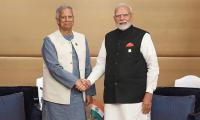The global average rate of inflation hovers around 3.2 percent. The rate of inflation in Pakistan hovers around 9 percent. The most recent Sensitive Price Index, comprising 51 essential items collected by the Pakistan Bureau of Statistics (PBS) from 50 markets in 17 cities, stands at 17.37 percent.
The global average GDP per capita is estimated to be $11,339 and the most recent estimate on Pakistan’s GDP per capita is $1,193. To be certain, the rate of inflation in Pakistan is at least 200 percent higher than the global average and the GDP per capita is a mere 10 percent of the global average.
In Pakistan, the average per capita income stands at Rs16,000 a month. An average Pakistani consumes 125 kilogram of flour a year and flour is now selling at Rs75 per kilogram, up 100 percent from three years ago. An average Pakistani consumes 25 kilograms of sugar a year and sugar is now selling at Rs160 per kilogram up 200 percent from three years ago. An average Pakistani consumes 450 kWh of electricity and the price of electricity has gone up from Rs11 a unit to Rs23 a unit. How much flour, sugar and electricity can an average Pakistan now buy?
Yes, food prices are ticking higher the world over. Food prices in the United States, for instance, were 4.6 percent higher than a year ago while Pakistan’s SPI was higher by 17.37 percent. To be sure, higher food prices do not hurt everyone equally – higher food prices are much more painful in countries where households spend a greater percentage of their income on food. An average American, for instance, spends 6.5 percent of his or her household income on food while in Pakistan the average Pakistani spends a wholesome 41.4 percent of his or her household budget on food. The poorer one is the higher is the percentage of income spent on food.
As per the ‘International Food Security Assessment 2021-31’ by the United States Department of Agriculture (USDA), 38 percent of Pakistan’s population is now ‘food insecure’ – that’s 90.7 million Pakistanis. In Nepal, 13.6 percent of the population is food insecure; Sri Lanka 19.4 percent, Bangladesh 25.7 percent and India 25.8 percent. Pakistan: 38 percent!
According to the Asian Development Bank (ADB), a one percent increase in food inflation “leads to an increase of 0.3 percent in both infant and child mortalities, and 0.5 percent in undernourishment.” According to Unicef, “In Pakistan, 38 percent of the children under five years of age are stunted (meaning: their height-for-age is below World Health Organisation’s ‘Child Growth Standards’).
Then there’s the burden of ‘wasting’ in Pakistani children under five years of age (wasting is defined as low weight-for-height). Shockingly, 6.7 million Pakistani children under the age of five suffer from wasting. Cause: acute malnutrition (this according to Unicef). With 1 percent increase in the rate of inflation there is 1.78 percent increase in poverty. No wonder at least 40 percent of Pakistanis have now fallen below the line of poverty.
Food inflation means four things: heightened food insecurity, an increase in poverty and widespread child stunting and wasting. We are now in the midst of the worst vicious cycle in our seventy-four year financial history: skyrocketing inflation is devaluing the rupee and the devaluation is blowing up inflation.
The writer is a columnist based in Islamabad.
Email: farrukh15@hotmail.com Twitter: @saleemfarrukh
According to Chanakya, secret of strong nation lies in ability to protect its citizens
Rapid economic progress was made possible under Modi's leadership if not ‘Modi's guarantee’
Pakistan was considered water-abundant country, with per capita water availability being 5650 cubic meters in 1951
Shrine of Mian Mir.—TheNews/FileMy history professor once referred to a theory that says the developmental telos of...
If Pakistan does not take prompt and decisive action, it could find itself at forefront of world's first water conflict
Please note that dam survey team from World Bank had proposed building of this dam in 1955







